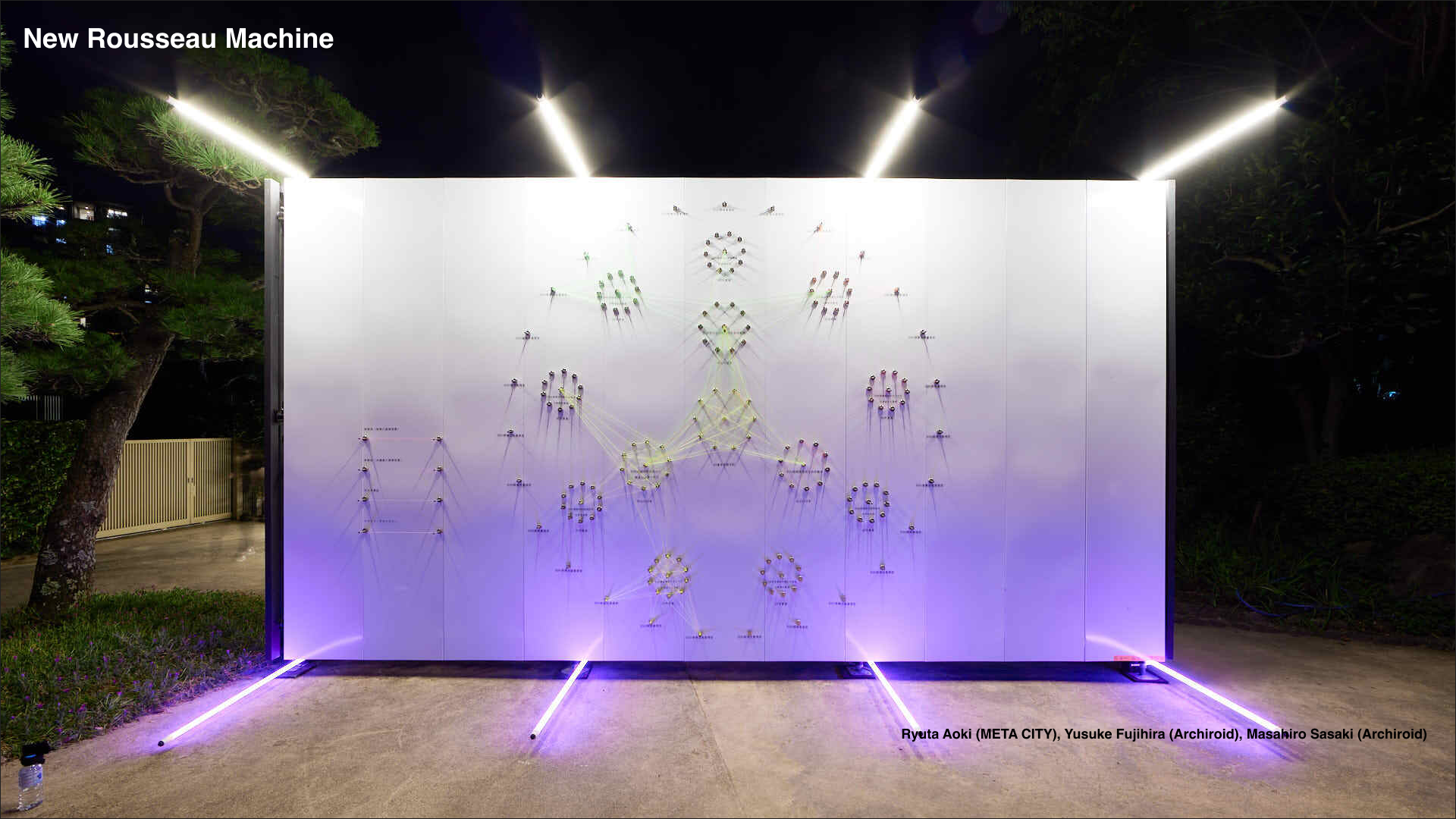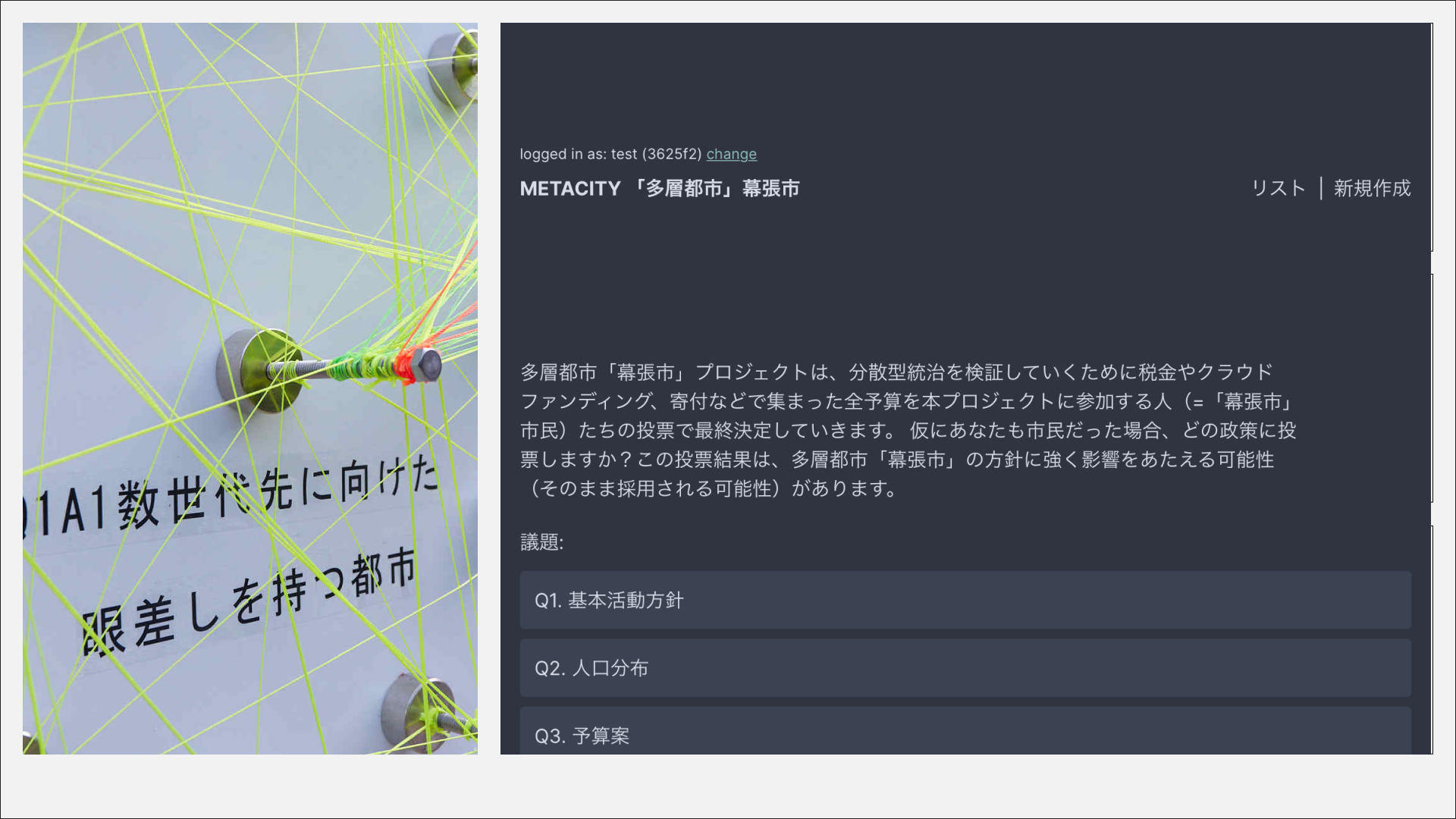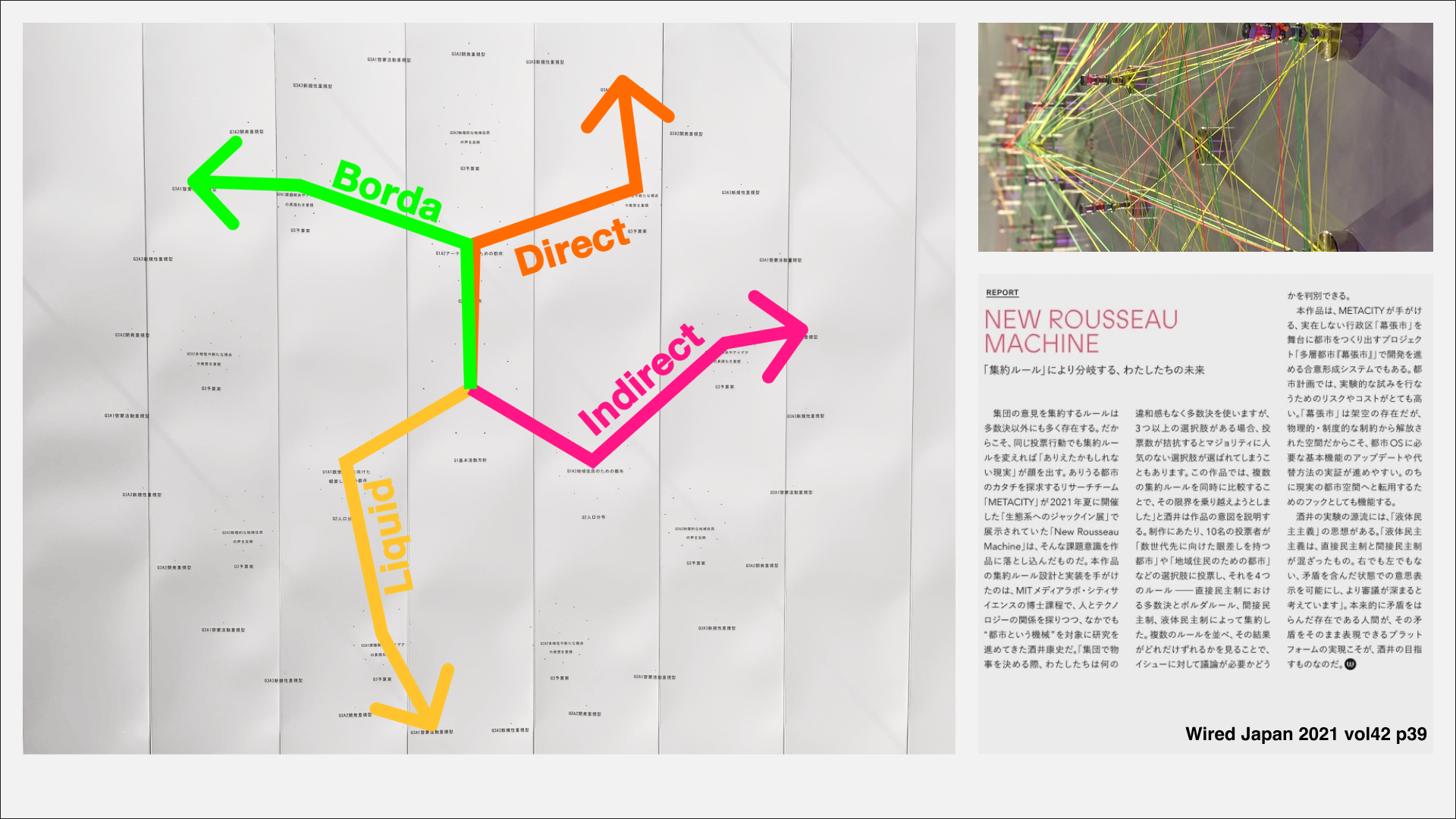New Rousseau Machine



Multi-Layered City “Makuhari” Project is a participatory art project to create a fictional administrative district “Makuhari City” with the governance system “New Rousseau Machine” developed by the research team “METACITY.”
This work was showcased at “The Exhibition of Jack into the Noösphere” held in Chiba City, Tokyo in the summer of 2021.
Introduction
Rather than starting with improvements to an existing city, we the “METACITY” research team began to develop governance mechanisms first to seek an alternative to the city’s shape that we now know and live.
Under this concept, we developed a multi-rule voting governance system, The “New Rousseau Machine,” that outputs different voting results using four separate aggregation rules. To test this system, we ran an example poll to show that the results derived by the four rules would not always converge into the same outcome. Those different outcomes were projected with threads and a temporal steel wall both used widely in construction sites. Visitors will imagine the future while observing the diverging paths of the multi-universe, generated by different methods of counting votes.
The votes collected by the people participating in this project (i.e., the citizens) will define the direction of the “Multi Layer City -Makuhari-” by voting on three topics. The budget for the coming projects will entirely raised through participation fees (taxes), crowdfunding, and donations to verify decentralized governance.
The system borrows efforts from distributed systems for transparency and tamper-proof. Further development of this project seeks to be an decentralized autonomous organization (DAO) that it’s interest revolving around the cultivation of art and culture.
Voting Interface and Aggregation Rules
The votes were collected through a web interface shown below. The image shows the interface for one topic among a total of three. The web interface has two sections; one asking how much the participant prefers each direct policy or plan and the second asking how much he/she is willing to delegate for that topic.
For each single act of voting using the above interface, we calculated voting results according to the following four aggregation rules.
Direct democracy
The aggregation of the votes for the single most supportive policy in each category. This rule excludes the second section; proxy voting.
Indirect democracy
A popular vote was taken among the delegates. Votes that target direct policy will be discarded except votes from the winning delegate.
Borda count
A system in which proxy votes are excluded, but the rankings of each direct vote item are determined. The lowest-ranked option gets 0 points, the next-lowest receives 1 point, etc., and the highest-ranked candidate gets n − 1 points, where n is the number of policies.
- Liquid Democracy
A voting method that combines direct and indirect democracy. Each paticipant can give fractional votes to either policies or to delegates. Points were normalized and counted in a recusive manner. A detailed explaination is here.
Topics
We asked the participants to vote on following three questions that would help us decide the future direction of Makuhari City. In addition to the direct vote on each topic, we also asked the participants how much they would trust within five delegates to handle this topic and asked for indirect proxy votes for the delegates at the same time.
Q1: Overall Policy
Option 1: A city with an eye toward future generations
The project will explore different methods of urban management, including the essential functions of a city, such as collective consensus building and festivity. In collaboration with urban researchers and engineers worldwide, we will develop new systems and conduct demonstrations of globally acclaimed institutions in the physical Makuhari area (Hanamigawa and Mihama wards of Chiba City). We will hold international conferences and support the production of demonstration experiments and research projects and position the city itself to become a world-class urban research institution. We will also actively support the update of Chiba City’s administrative services, transforming it into a city that reflects the will of its citizens the most.
Option 2: A city with artists, by artists, for artists
In Japan, where the promotion of culture is still in its infancy, we will create a new mutually supportive system for artists scattered throughout Japan as citizens, including financial support without depending on governmental subsidies and function as a platform for sharing ideas and networks. We will also approach the budget of Chiba City, which is an actual administrative district. Basing this physical area will establish itself as a sacred place for artists in Japan, contributing to the site’s recognition and creating a lively atmosphere.
Option 3: A city for the local residents
Makuhari City, an imaginary city, does not have a physical presence but will be maintained with its independent budget and personnel. Yet, as we use the word “Makuhari,” we will carry out activities that will benefit people living in the physical Makuhari area (Hanamigawa and Mihama wards of Chiba City) in some way over the next few years. We will work closely with Chiba City to directly contribute to the DX promotion of existing government services. This concept is not new, but it will undoubtedly provide a suitable living environment for residents and will likely support the local community and government.
Q2: Demographics
The Multilayer city “Makuhari” will be governed in a decentralized manner; the preferences and characteristics of each resident strongly reflect the fabric of the town. If you could control the attributes of the citizens in advance, what kind of population distribution do you think would be desirable? Imagine a city you would like to live in and choose one. Note that you do not have to follow the policy in Q1. For example, even if you chose “city for artists” in Q1, the low percentage of artists will not contradict. The selected option be interpreted as the lowest percentage of human resources to accomplish the basic policy chosen in Q1.
For example, the following assumptions can be made:
More artists and researchers: New perspectives and ideas will emerge without being bound by existing concepts and rules. There will be a greater openness to a variety of views. They like diversity and may move toward a more chaotic environment.
More designers and architects: Problems that many people do not recognize will be extracted and solved in a way that balances use and beauty. The world view of a particular designer will be reflected, and the environment will become more orderly.
More engineers: Not just ideas, but their actual realization will be valued.
More physical residents of the Makuhari area: Policies that prioritize the community for children and inclusiveness will increase. The trend may avoid risk-taking, and views making the environment safer and secure will be valued.
- Option 1: Focusing on problem solving and idea realization
- Option 2: Focus on diversity and new perspectives and ideas
- Option 3: Focus on residents from Makuhari area
| Option 1 | Option 2 | Option 3 | |
|---|---|---|---|
| Artists | 10% | 40% | 15% |
| Scientists | 10% | 30% | 15% |
| Engineer | 40% | 10% | 15% |
| Designer | 30% | 10% | 15% |
| Local Res. | 10% | 10% | 40% |
Q3: Budget distribution
- Option 1: Enlightenment Oriented
- Option 2: System Development Oriented
Option 3: Novelty Oriented
| Option 1 | Option 2 | Option 3 | |
|---|---|---|---|
| R&D | 10% | 20% | 50% |
| Education | 10% | 10% | 10% |
| Promotion | 50% | 10% | 10% |
| System Development | 20% | 50% | 20% |
| Admin | 10% | 10% | 10% |
Wall Art & Results
Threads used in construction sites visualize the results of votes for each aggregation rule. The colors indicate the different rules.
| agg. rule | Overall direction | target demographic | budget | thread color |
|---|---|---|---|---|
| direct | city for artists | diversity oriented | outreach focus | orange |
| indirect | city for locals | solution oriented | development focus | red |
| borda | city for artists | solution oriented | outreach focus | green |
| city for the future generation | solution oriented | outreach focus | yellow |
Media Coverage
Credits
Concept and System Development: Yasushi Sakai, Ryuta Aoki, Masahiro Sasaki, Yusuke Fujihira
Planning Support: Hiroki Yoshida
Collaboration: MIT Media Lab City Science, Archioid
Special Thanks: Masahiro Mitsui